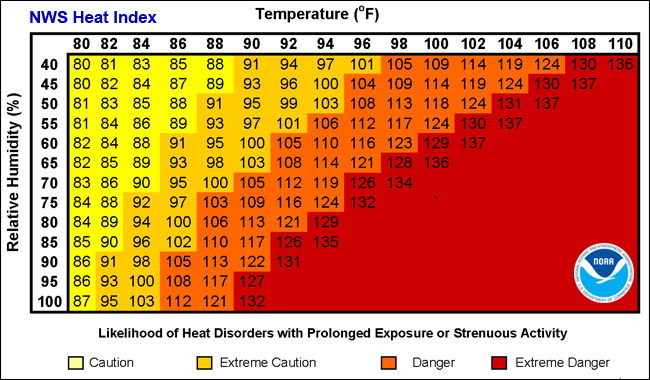
Heavy rains will bring potential flash flooding to portions of the lower Mississippi Valley early this weekend. Across the Pacific Northwest, an atmospheric river event is set to arrive by Sunday, bringing heavy coastal rains and high elevation snowfall. Above average temperatures continue for much of the country through the weekend. Read More >
| What is the heat index? |
| "It's not the heat, it's the humidity". That's a partly valid phrase you may have heard in the summer, but it's actually both. The heat index, also known as the apparent temperature, is what the temperature feels like to the human body when relative humidity is combined with the air temperature. This has important considerations for the human body's comfort. When the body gets too hot, it begins to perspire or sweat to cool itself off. If the perspiration is not able to evaporate, the body cannot regulate its temperature. Evaporation is a cooling process. When perspiration is evaporated off the body, it effectively reduces the body's temperature. When the atmospheric moisture content (i.e. relative humidity) is high, the rate of evaporation from the body decreases. In other words, the human body feels warmer in humid conditions. The opposite is true when the relative humidity decreases because the rate of perspiration increases. The body actually feels cooler in arid conditions. There is direct relationship between the air temperature and relative humidity and the heat index, meaning as the air temperature and relative humidity increase (decrease), the heat index increases (decreases). |
 Figure 1. Heat index chart. |
| In order to determine the heat index using the chart above, you need to know the air temperature and the relative humidity. For example, if the air temperature is 100°F and the relative humidity is 55%, the heat index will be 124°F. When the relative humidity is low, the apparent temperature can actually be lower than the air temperature. For example, if the air temperature is 100°F and the relative humidity is 15%, the heat index is 96°F (use this calculator). In the Panhandles, we commonly see hot temperatures during the summer, but the low relative humidity values make it somewhat unusual to see dangerous heat index values (i.e. 103°F or greater). A full heat index chart for a larger range of temperatures and relative humidity values can be found at this link. |
|
It surprises many people to learn that the heat index values in the chart above are for shady locations. If you are exposed to direct sunlight, the heat index value can be increased by up to 15°F. As shown in the table below, heat indices meeting or exceeding 103°F can lead to dangerous heat disorders with prolonged exposure and/or physical activity in the heat.
|
Use this weather calculator if you prefer to enter numbers manually instead of reading a chart. If you're really mathematically inclined, there is an equation that gives a very close approximation to the heat index. However, this equation was obtained using a multiple regression analysis, and therefore, it has an error of ±1.3°F.
Heat Index = -42.379 + 2.04901523T + 10.14333127R - 0.22475541TR - 6.83783 x 10-3T2 - 5.481717 x 10-2R2 + 1.22874 x 10-3T2R + 8.5282 x 10-4TR2 - 1.99 x 10-6T2R2
T - air temperature (F)
R - relative humidity (percentage)